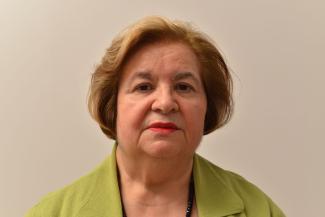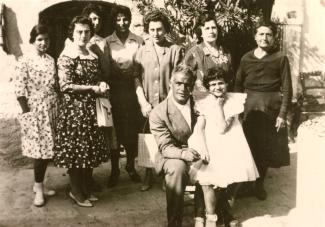Faustina Bilotta’s first-hand experience of discrimination and exploitation led her to become an advocate for the rights of immigrant women.
As part of the Women’s Stories of Migration project, the MEM – Centre des mémoires montréalaises met with women who have settled in Montréal from elsewhere to hear about their experiences. Our Stories series maps unique life paths that intersect across the city, shaping its history.
—
Faustina Bilotta

Faustina Bilotta was sixteen when she arrived in Montréal in 1963. She had left her village of Casalciprano, in Molise, Italy, to pursue language studies. Her plan was to learn French in Quebec, where her sister had settled a few years earlier. But that dream was shattered when Montréal’s Catholic school board, the Commission des écoles catholiques de Montréal (CECM), denied her access to French schooling. She went on to work briefly in a factory, where conditions were very difficult. The two experiences would change the course of her life, making her a passionate advocate for the rights of immigrant women. In January 2019, the MEM met Faustina to hear her story.
Un cas méconnu
Faustina Bilotta vers 1963

Cases like Faustina’s shed light on how complex the issue was for people of Italian origin in the 1960s. Faustina points out that Italians were denied access to the French language. “[Catholic school officials] pushed us into English Protestant schools, which were not our first choice, given our religion. The result was a language barrier,” she says. “When the laws were passed—and I think the government was right [to adopt them] to defend the French language—Italians were perceived as resisting that goal. But that wasn’t accurate. Italians just wanted their children to be able to learn several languages to ensure their economic well-being.” Faustina’s situation was not unique.
In fact, up to that point, policy makers in Quebec had given little thought to the question of integration. Italian Montrealers had begun settling in the country in the early 1900s. Over the years, members of the Italian community had opted for a variety of educational formulas, including trilingual, bilingual, French and English schools. Historically, the Catholic CECM was not welcoming to immigrant students, in contrast to the English-language Protestant School Board. And, as Faustina points out, while many newcomers wanted to learn French, they perceived English as synonymous with economic advancement—an important consideration for people in search of a better life. In Faustina’s case, the CECM’s rejection was the first obstacle to integrating into Montréal life. Her story highlights an often-overlooked dimension of the history of the Italian community in Montréal and its language concerns with regard to schooling.
Factory work
Faustina Bilotta 1968

While waiting to be admitted to an English Protestant school, Faustina spent a few months working in a textile factory. In the 1960s, textile manufacturing was one of Montréal’s main industries. For decades already, critics had denounced the working conditions that women— notably immigrant women—experienced in its sweatshops.
Faustina explains, “The factories employed mostly immigrant women—Italian, Portuguese, and especially Greek. I could see how exploited they were. They earned very little, and to make a living wage, they had to do piecework.” This realization, along with the discrimination she had experienced in the school environment, pushed Faustina to become involved in supporting immigrants. She began by focusing on her own community.
Italian life in Montréal
Faustina Bilotta 2018

Faustina came to Canada as part of the great wave of immigration that occurred after the Second World War. Between 1941 and 1971, the Italian population in Montreal increased from 24,000 to 109,000. By the time Faustina arrived, the Italian community had already established many community organizations. “The associations, which still exist today, brought together people who came from the same village,” says Faustina. “In Italy, everyone in the village would gather a few times a year to mark important events. Italians reproduced that structure here, as a way to stay in touch, celebrate, and so on. … Back then, everything happened within those circles. It was a very social life.”
The organizations were vital resources for newcomers at a time when integration was hardly on the government agenda. “There wasn’t the kind of structure for newcomers that exists today. You weren’t told, ‘This is where you will be, these are their customs, here’s what you need to do,’” recalls Faustina. “If you didn’t have a job, you couldn’t survive, because there was no ‘social welfare.’ There was nothing.” Grateful for the support she had received from her community, she became involved in various organizations, including the Congrès italo-canadien, where she still volunteers today.
A lifelong commitment
Faustina studied fashion design, and then art history—in French—at UQAM, all while raising two sons and working professionally and as a volunteer. Along the way, she met Aoura Bizzarri, head of the Collectif des femmes immigrantes du Québec (Le Collectif), an organization that advocates for the rights of immigrant women and supports their integration. The cause was especially close to Faustina’s heart. In 2019, she celebrated her twentieth year as a member of Le Collectif’s board, including ten years as its president. Her humanistic vision has guided her throughout her career. “I never see an immigrant. I see a human being.”
As often happens when a new ethnocultural community arrives in a country, the Italians who came to North America from the 1900s on were targeted by racial slurs. One was “wop,” a word of disputed origin, likely derived from the Spanish word guappo.
Faustina notes that, a century later, her sons still endure the slur at work. She also points to the negative stereotypes that persist in coverage of such events as the Charbonneau Commission, an investigation into corruption in the management of public construction contracts. “It gave the impression that all Italians are mobsters. But the mafia doesn’t exist only in Italy. … It exists everywhere,” says Faustina. “When something bad happens, Italians are always to blame. It follows us to this day. … And when you feel stereotyped, you withdraw. When an Italian becomes a politician or an artist, nobody mentions their origins. … But if they’re involved in organized crime, suddenly they’re Italian again. … Because of a handful of people, the entire community is stigmatized.”
CATAUDELLA, Mario. « Quelques considérations sur les facteurs du retard économique du Molise », Méditerranée, no 14, 1973, p. 23-49.
LINTEAU, Paul-André. « Les grandes tendances de l’immigration au Québec (1945-2005) », Migrance, no 34, 2009.
LINTEAU, Paul-André et al. Histoire du Québec contemporain. Le Québec depuis 1930, Boréal, Montréal, 1989, p. 567- 593.
ONLINE ETYMOLOGY DICTIONNARY. « Wop », [En ligne], Online Etymology Dictionnary.
https://www.etymonline.com/word/wop
POLÈSE, Mario. « Montréal économique : de 1930 à nos jours. Récit d’une transition inachevée », Histoire de Montréal et de sa région, Tome II, Québec, Presses de l’Université Laval, 2012, p. 993.



